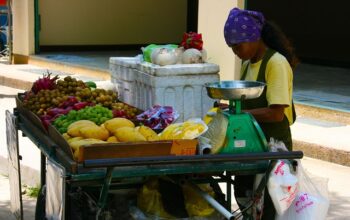Local food delivery and meal preparation services have transformed in response to the rise in food allergies and intolerances, offering customizable, allergen-aware options that cater to specific dietary needs. These services ensure safe and enjoyable meals for those with conditions like gluten intolerance or life-threatening nut allergies by partnering with knowledgeable providers who strictly adhere to food safety protocols. They provide a wide array of flavors and cuisines, all prepared with the individual's health in mind, thus improving their quality of life while also contributing to a safer dining environment for everyone. The integration of allergy-conscious dining options within these services reflects a critical adaptation to dietary restrictions, driven by environmental influences, evolving dietary habits, and heightened public awareness. These services use sophisticated filtration technologies, stringent preparation practices, and local sourcing to guarantee safe, allergen-free meals, ensuring peace of mind for consumers while supporting local economies and reducing carbon footprints. With a commitment to rigorous protocols, staff training in allergen awareness, transparent communication, and comprehensive ingredient lists, local food delivery services have established themselves as a trustworthy and essential component of meal preparation for individuals with special dietary requirements, aligning with broader trends in safe, nutritious, and sustainable dining practices.
Navigating the complexities of food allergies and intolerances has become increasingly crucial in our diverse culinary landscape. As local food delivery services expand, they offer tailored solutions for those with dietary restrictions. This article delves into the nuanced differences between food allergies and intolerances, examines their rising prevalence globally, and highlights how innovative local meal services are stepping up to meet these challenges head-on. We’ll explore key strategies for safe food handling, the impact of technology in ensuring allergen avoidance, and how to select a delivery service that caters to your specific dietary needs. From meal planning tips to label reading advice, this comprehensive guide equips readers with the knowledge to safely manage their conditions while enjoying delicious, local cuisine.
- Understanding the Difference Between Food Allergies and Intolerances
- The Rise of Food Allergy and Intolerance Cases Globally
- Customized Local Food Delivery Services as a Response to Dietary Restrictions
- Key Considerations for Safe Food Handling in Meal Preparation
Understanding the Difference Between Food Allergies and Intolerances

navigating the complexities of dietary restrictions can be a daunting task for individuals and food service providers alike. With a rise in both food allergies and intolerances, it’s crucial for those affected to have access to safe, enjoyable meals. Understanding the difference between the two is key to ensuring appropriate accommodations. Food allergies are immune system responses to specific proteins found in certain foods. They can trigger potentially severe reactions, such as anaphylaxis, and require stringent avoidance measures. On the other hand, food intolerances are generally less immediate or life-threatening than allergies but still significant in their impact on health and well-being. Intolerances often involve difficulty digesting certain foods, leading to discomfort or adverse health effects. For individuals managing these conditions, local food delivery and meal preparation services have become invaluable resources. These services offer customizable options that cater specifically to dietary needs, ensuring that those with allergies or intolerances can still enjoy a variety of flavors and cuisines without the risk of exposure to trigger foods. By partnering with reliable providers who are knowledgeable about food safety protocols, individuals with these restrictions can maintain a balanced and nutritious diet with the convenience and peace of mind that comes from knowing their meals are prepared with their health in focus. This not only enhances their quality of life but also promotes a safer dining experience for the entire community.
The Rise of Food Allergy and Intolerance Cases Globally

The prevalence of food allergies and intolerances has seen a significant rise globally, prompting a shift in how local food delivery services and meal preparation businesses operate. Environmental factors, changes in dietary patterns, and increased awareness are contributing to this upward trend. As more individuals are diagnosed with specific food sensitivities, the demand for allergy-aware dining options has escalated. Local food delivery platforms have adapted by implementing rigorous filtering systems that allow consumers to identify meals suitable for their dietary restrictions. These services often provide detailed information on ingredient sources and preparation environments, ensuring transparency and safety for those with allergies or intolerances. Similarly, meal preparation companies have recognized the need for specialized menus that cater to these dietary needs, offering customizable plans that can be tailored to avoid specific ingredients. This adaptability not only helps in managing individual health concerns but also expands market reach, as individuals with such conditions often feel marginalized in traditional dining settings. The rise of food allergy and intolerance cases has thus led to a more inclusive and accommodating food industry on a local scale, ensuring that consumers have access to safe and enjoyable meal options regardless of their dietary limitations.
Customized Local Food Delivery Services as a Response to Dietary Restrictions

The rise in food allergies and intolerances has spurred a significant shift in the culinary landscape, with local food delivery services adapting to meet the diverse dietary needs of consumers. These customized local food delivery services have become a beacon for those with specific dietary restrictions, offering tailored meal options that cater to individual health requirements without compromising on taste or quality. By leveraging advanced filtration systems and strict preparation protocols, these services ensure that meals are prepared in safe environments, minimizing the risk of cross-contamination. The convenience of having personally curated menus delivered directly to one’s doorstep cannot be overstated, as it empowers individuals with dietary restrictions to enjoy a variety of dishes without the anxiety of unintended exposure to allergens or intolerance triggers. Moreover, these services often collaborate with local farmers and producers, promoting fresh, high-quality ingredients while supporting the community’s economy. This synergy between dietary needs and local produce not only enhances the nutritional value of the meals but also reduces the carbon footprint associated with food transportation. As a result, local food delivery services have become an integral part of meal preparation for those with special dietary considerations, offering a viable and convenient solution in the quest for safe and satisfying dining options.
Key Considerations for Safe Food Handling in Meal Preparation

When catering to individuals with food allergies and intolerances, safe food handling is paramount in meal preparation, particularly within the context of local food delivery services. To mitigate risks, establishments must implement stringent cross-contamination prevention measures. This includes designating specific areas for allergen-free food prep, utilizing separate utensils and cookware, and thoroughly cleaning all surfaces before and after preparing meals. Ensuring that staff are trained in allergen awareness is equally critical; they should be well-versed in ingredient sourcing, proper labeling, and safe food storage practices. For local food delivery services, this translates to clear communication with customers about potential allergens in their meals and the precautions taken to avoid them. By providing detailed ingredient lists and ensuring that orders are packed separately if necessary, these services can offer peace of mind to customers with dietary restrictions. In doing so, they not only comply with food safety regulations but also enhance customer satisfaction and trust in local food delivery options. Adhering to these practices safeguards the health of consumers and promotes a reliable service within the meal preparation industry.
In conclusion, the increasing prevalence of food allergies and intolerances necessitates a nuanced approach in both local food delivery services and meal preparation. As highlighted throughout this article, understanding the distinctions between these conditions is paramount for safe and enjoyable dining experiences. The rise in cases globally underscores the importance of tailored solutions, such as customized local food delivery options that cater to specific dietary needs. Key considerations for safe food handling must be prioritized in meal preparation to protect individuals’ health. By integrating these practices into the culinary landscape, we can ensure a more inclusive and accommodating food culture that respects and addresses the diverse needs of consumers. Local food delivery services and thoughtful meal preparation are not just innovative responses but essential components of a society that values health, safety, and inclusivity for all its members.



